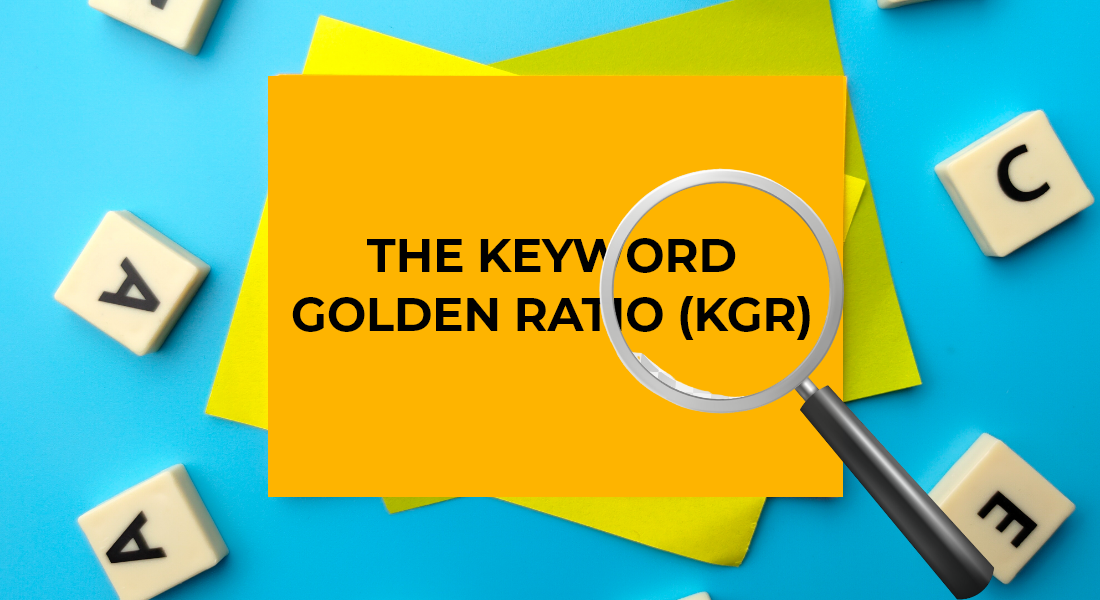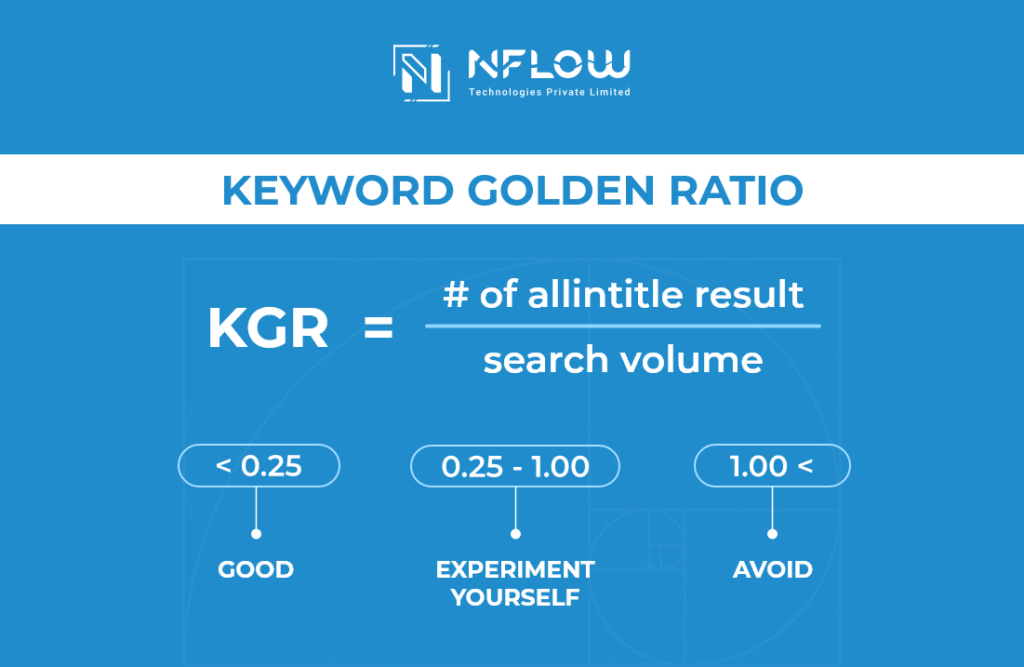
The Keyword Golden Ratio (KGR) is an SEO strategy designed to help websites, particularly newer or smaller ones, identify low-competition, long-tail keywords that can be ranked for quickly. By focusing on these specific keywords, content creators aim to achieve higher search engine rankings with less effort compared to targeting more competitive terms. By focusing on these specific keywords, website owners, especially those with newer sites, can achieve quicker visibility and traffic.
What Is the Keyword Golden Ratio (KGR)?
At its core, the Keyword Golden Ratio is a formula designed to identify long-tail keywords with low competition and sufficient search volume. These keywords are often overlooked by competitors, making them ideal targets for smaller or newer websites. The formula for calculating KGR is:

The ideal KGR value is less than 0.25. Keywords meeting this criterion are considered “golden,” as they offer high-ranking potential with minimal effort. The monthly search volume for these keywords should generally be capped at 250 searches to ensure faster ranking.
How to Calculate the Keyword Golden Ratio
The KGR is calculated using the following formula:
KGR = (Number of Google results with the keyword in the title) / (Monthly search volume)
To apply this method:
- Identify Long-Tail Keywords: Focus on keywords with a monthly search volume of 250 or less.
- Assess Competition: Use the “allintitle” search operator in Google to determine how many pages have the exact keyword in their title. For example, searching allintitle:best running shoes for flat feet will show the number of results with this exact phrase in the title.
- Calculate the Ratio: Divide the number of “allintitle” results by the monthly search volume.
Specifically, the “number of Google results with the keyword in the title” refers to the count of pages that have the exact keyword phrase in their title tags. This can be determined using the allintitle: search operator in Google. For example, if a keyword phrase has 50 allintitle: results and a monthly search volume of 200, the KGR would be: KGR = 50 / 200 = 0.25 The general guideline is:
- KGR < 0.25: The keyword is considered easy to rank for, and pages optimized for it are likely to appear in the top 100 search results quickly.
- 0.25 – 1.00: Moderate competition; ranking may require more effort.
- KGR > 1.00: High Competition; ranking will be challenging without significant SEO efforts.
It’s important to note that the KGR method is most effective for keywords with a monthly search volume of less than 250. This focus on low-volume keywords ensures that the competition remains minimal, increasing the chances of ranking success.
Benefits of Using KGR
- Rapid Ranking: By targeting low-competition keywords, content can rank in search results within days, sometimes even hours, of being published.
- Ideal for New Websites: New domains often struggle to rank for competitive keywords due to a lack of authority. Focusing on KGR keywords allows these sites to gain initial traction and build credibility.
- Cost-Effective: Achieving rankings without the need for extensive backlink campaigns or paid PPC promotions can save resources and reduce marketing expenses.
- Efficient Content Strategy: Focusing on KGR keywords allows for the creation of content that meets specific search intents, leading to better user engagement.
Limitations of KGR Formula
While the KGR method offers several advantages, it’s not without its criticisms and limitations:
- KGR ≠ Guaranteed Ranking: It’s one data point. Actual ranking depends heavily on content quality, relevance, site authority (E-E-A-T signals), backlinks, user experience, technical SEO, the overall competitiveness of the niche, and algorithm updates. A KGR of 0.0 doesn’t guarantee page 1.
- Reliance on Search Volume Accuracy: KGR calculations depend on accurate search volume data, which can vary between tools and may not always reflect real-world search behavior.
- Semantic Search Factors: Modern search engines utilize semantic analysis, meaning they understand context beyond exact keyword matches. Therefore, a page can rank for a keyword even if the exact phrase isn’t in the title.
- Risk of Keyword Stuffing: Overemphasis on exact-match keywords can lead to unnatural content and keyword stuffing, which can harm user experience and violate search engine guidelines.
- “allintitle” Flakiness: The allintitle count can fluctuate and isn’t always precise. Google might show an estimated number. Furthermore, a low count doesn’t tell you the strength or relevance of those competing pages. Ten weak, irrelevant pages are less of a barrier than one highly authoritative, perfectly optimized page.
- Outdated Tactic: Some SEO professionals argue that KGR is an outdated method and may not be as effective in the current search landscape.
Advanced Techniques to Enhance KGR Effectiveness
To maximize the benefits of the KGR method, consider integrating the following strategies:
- Semantic Keyword Integration: Beyond targeting exact-match KGR keywords, incorporate semantically related terms and synonyms within your content. This approach aligns with modern search engine algorithms that prioritize topic relevance over exact keyword matches. By doing so, you can capture a broader range of search queries and improve content depth.
- Internal Linking Structure: Establish a robust internal linking framework to connect KGR-targeted pages with related content on your site. This not only aids in distributing page authority but also enhances user navigation and dwell time.
- Rule of 63: For keywords with a search volume exceeding 250, some practitioners suggest targeting keywords where the number of allintitle results is 63 or fewer. This approach aims to maintain a manageable level of competition even for higher-volume keywords.
- Content Quality and Topical Authority: Beyond identifying low-competition keywords, focus on creating high-quality, comprehensive content that addresses user intent. Building topical authority by covering related subtopics can enhance credibility and improve rankings.
- Avoiding Over-Reliance on Title Tags: While the KGR emphasizes the importance of title tags, remember that search engines consider multiple factors. Ensure that your content is well-structured, informative, and provides value beyond just matching the keyword in the title.
- Prioritizing User Intent: Understanding the intent behind search queries ensures that the content not only ranks but also satisfies user needs, leading to better engagement and conversion rates.
- Balancing KGR with User Experience: While targeting low-competition keywords is beneficial, it’s crucial not to compromise on user experience. Ensure that content is engaging, informative, and aligns with what users are searching for.
In conclusion, the Keyword Golden Ratio offers a systematic approach to uncovering and targeting low-competition keywords, especially beneficial for newer websites aiming for quick visibility. However, its success is contingent upon high-quality content, a deep understanding of user intent, and adaptability to the ever-evolving landscape of search engine algorithms.

Nevil Bhatt
Nevil is the owner of one of the fastest-growing digital marketing agency in India. Having a great knowledge of the IT field and business management, he decided to bring a revolution in the digital world by providing valuable and customised solutions across the globe. Whether it's real or digital, he knows how to handle sustainable relationships and meaningful interactions.




